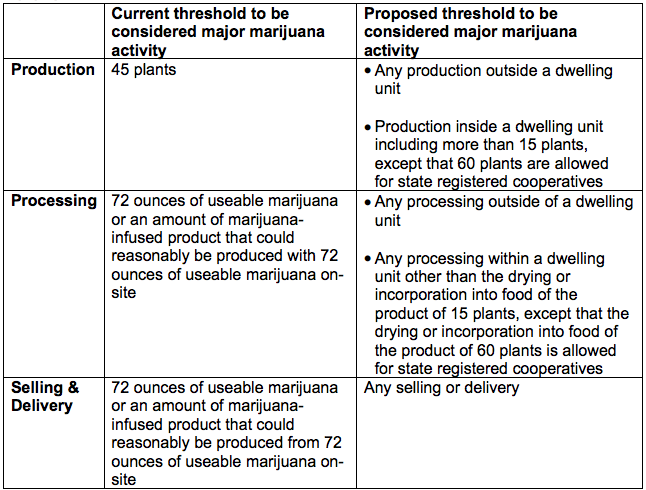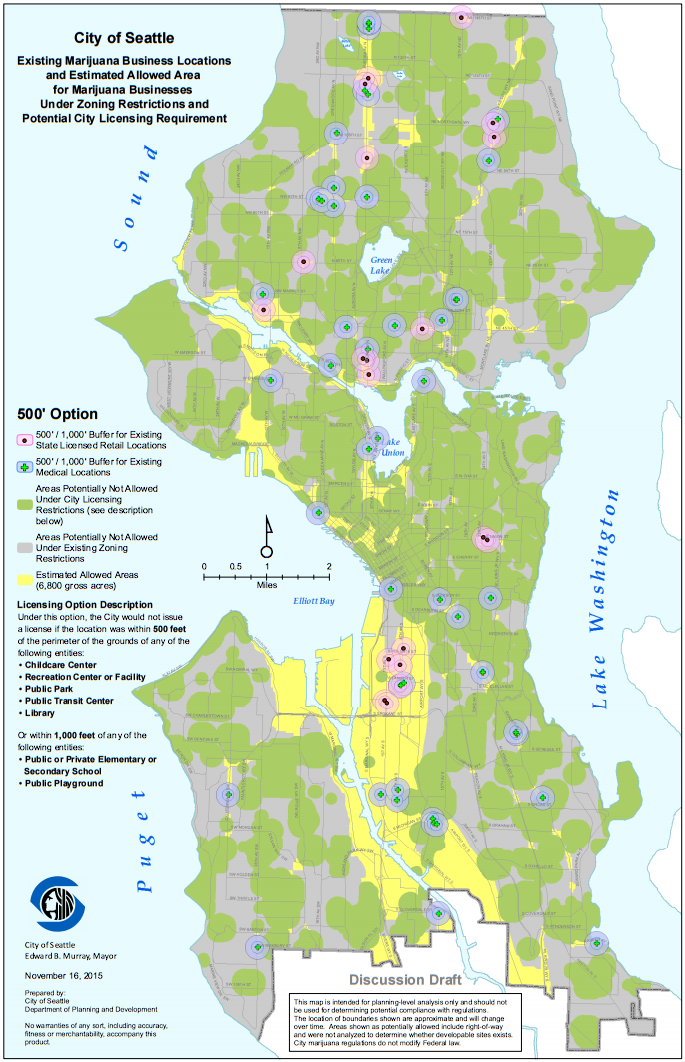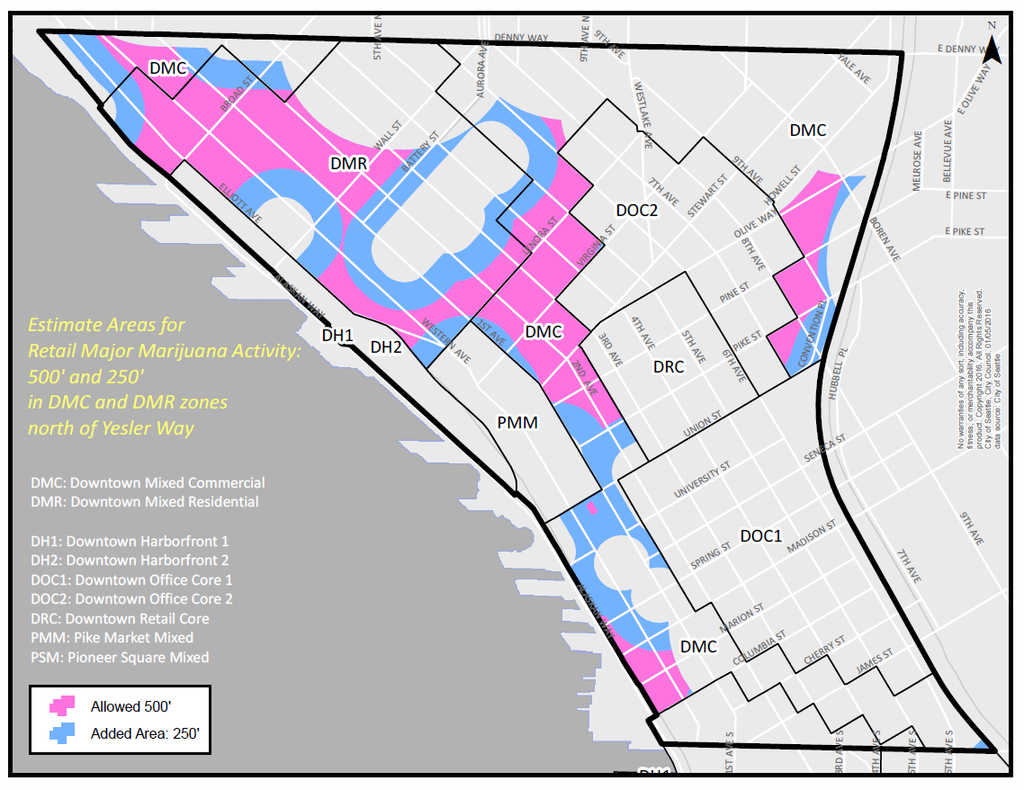Let’s talk pot. Washington voters passed Initiative 502, a proposal to legalize recreational marijuana production and consumption through the state, by a healthy margin in November 2012. Proponents of the law intentionally designed it as a pragmatic approach to recreational marijuana legalization. It was built upon the principles of safeguarding the public health and welfare, shielding the state from enforcement by the federal government, and establishing a regulatory system to manage a network of recreational marijuana proprietors. And in doing so, the initiative handed broad authority for the licensing of recreational marijuana facilities to the Washington State Liquor and Cannabis Board (WSLCB, formerly known as the Washington State Liquor and Control Board).
The WSLCB wasn’t immediately required to begin issuing licenses, but it did have a deadline set for December 1, 2013 to begin accepting formal applications for licenses. Over the course of a year, the WSLCB used its rulemaking authority to codify its processes and rules on licensing recreational marijuana facilities. And on July 8, 2014, the first retail marijuana stores opened ($) to the public.
Tough Locational Restrictions
The initiative codified specific buffer requirements under RCW 69.50.331 to limit proximity of recreational marijuana facilities from sensitive uses. Under the law, any recreational marijuana facility was required to be at least 1,000 feet away from the nearest sensitive use. The law further defined sensitive uses to include any of the following: elementary and secondary schools, playgrounds, recreation centers or recreation facilities, child care centers, public parks, public transit centers, and libraries; and game arcades that give admission to those under the age of 21. The definition of sensitive use is intentionally broad in order to keep recreational marijuana facilities away from areas that minors are likely to congregate or spend significant amounts of time in.
Early on in the rulemaking process, many recreational marijuana advocates were concerned about how the 1,000-foot buffer would be calculated. Would it be as the crow flies? Marijuana facility building to sensitive use? Linear feet as a pedestrian might walk between the uses? Or distance from property line to property line? Ultimately, the WSLCB settled on a relatively simple calculation method: buffers would be determined on the parcel level where a sensitive use or marijuana facility is located. If the closest parcel lines between the two properties were within 1,000 of each other, a license could not be granted.
These requirements on their own have made it very challenging for many recreational marijuana proprietors to find suitable sites under state law. But municipalities have added another layer to the complicated formula through local land use regulations. Some municipalities have decided to prohibit marijuana facilities outright while others have limited them to specific zoning districts with additional locational requirements like minimum lot sizes, separation from other marijuana facilities, and quantity caps. Recognizing these localized permitting challenges, state legislators adopted new provisions for buffer requirements as part of a retail and medical marijuana omnibus bill1 last summer.
Under revised rules, a local municipality may adopt an ordinance to reduce buffers around certain sensitive uses. The provisions allow for buffer reductions below 1,000 feet, but no fewer than 100 feet, and the ordinance must specify that the reduction does not apply to three types of sensitive use; those being elementary schools, secondary schools, and playgrounds. A related provision also allows for the same buffer reductions for the licensing of research marijuana facilities, but comes with additional security measure requirements and gives relief in the instances of elementary schools, secondary schools, and playgrounds.
The Proposal of the Executive Branch
Early on in the process, the Office of Planning and Community Development (OPCD, and formerly the Department of Planning and Development) evaluated a number of options to revise marijuana regulations within the city. Those proposals focused on three core areas for changes:
- A significant revision to the definition of Major Marijuana Activity;
- Establish new separation requirements for any Major Marijuana Activity; and
- Add a requirement for odor control for marijuana production and processing activities.

The first element of the proposal was meant to effectively capture all recreational activities for the production, processing, or sale of marijuana as a Major Marijuana Activity under the land use code. The purpose for the change came largely from a desire to fix unintended consequences with the original code. As it was, the Major Marijuana Activity definition had set specific thresholds for the amount of marijuana plants or products that could be created or sold without being subject to regulatory requirements. This, however, resulted in many recreational and medical marijuana businesses opening up without licensing from the State. The proposal, therefore, was to essentially exempt only qualified medical marijuana patients or designated provider to produce, process, and sell medical marijuana products on an individual dwelling basis.

The second element of the proposal was meant to ensure adequate separation of marijuana facilities and reduce buffers from sensitive uses, as allowed by new State law. OPCD looked at a few options for reduced buffers from sensitive uses, including one proposal that could have set buffers as low as 250 feet. But ultimately OPCD and Mayor put forth a plan to set buffers at 500 feet for child care centers, game arcades, libraries, public parks, public transit centers, and recreation centers or recreation facilities. Meanwhile, buffers from elementary schools, secondary schools, and public playgrounds were proposed to remain at 1,000 feet. Additionally, a new separation requirement between retail marijuana facilities was proposed to set new facilities at least 500 feet from any other existing retail marijuana facility.
The third, and final, element of the proposal was meant to better control odors that can result from the production and processing of marijuana. Using existing code on the books, the proposal sought to add Major Marijuana Activity as a use type subject to the odor control standards. Importantly, the standards allow the Department of Codes and Inspections the ability to require special mitigation like directing vents and pipes away from neighboring uses, adding filters, or eliminate odors.
Adopted Rules By Council
Legislation went through two rounds of committee review and intensive discussion by Councilmembers. An amended substitute bill came out of that process and the Council passed legislation that would be best characterized as more flexible for recreational marijuana proprietors than the original bill transmitted to Council. The redefined meaning of Major Marijuana Activity and added odor control standards essentially passed unchanged, but Councilmembers did make tweaks to the City’s policy on the buffer requirements from sensitive uses and separation between retail marijuana facilities.

In legislation passed by Council, buffer requirements will be treated differently depending upon the type of sensitive use, the type of marijuana activity, and location. In zoning districts where marijuana facilities are allowed, reduced buffers will be calculated from lots with a child care center, game arcade (allowing admission to people under the age of 21), library, public park, public transit center, or recreation facility. The new buffer requirements break down into four categories:
- Universally. A 1,000-foot buffer will still apply to three types of sensitive uses: elementary schools, secondary schools, and playgrounds.
- Retail-specific. A 500-foot buffer will apply from other sensitive uses in zones where retail marijuana facilities are allowed, except that a 250-foot buffer2 will apply from other sensitive uses in Downtown commercial zones where marijuana facilities are allowed; and
- Production- and processing-specific. A 250-foot buffer3 will apply from other sensitive uses in zones where marijuana production and processing facilities are allowed.
On top of the buffer requirements, the Council also adopted a different separation requirement4 between retail marijuana facilities than proposed by the Mayor. No more than two retail marijuana facilities will be allowed within 1,000 feet from each other; should a third (or more) retail marijuana facility be located in proximity to two retail marijuana facilities matching the aforementioned criteria, then it shall be located at least 1,000 feet away from both of them.
Challenges Will Remain
Despite these changes, opening retail marijuana facilities will remain a challenge. To date, nearly 300 applicants have requested a retail and/or medical marijuana license to operate within Seattle. Yet, only 42 licences are available from the WSLCB at this time, and 30 of them have been allocated so far. The WSLCB is likely allocate the remaining 12 licenses, which are part of a statewide proposal to increase the number of licenses available in local municipalities4. But that still means that there are well over 20 applicants6 for every license likely to become available, which is why the WSLCB has created a priority system that rewards businesses that have been operating the longest and most legally. Regardless of the regulatory changes that Seattle has made, not every proprietor will be able to get a retail marijuana license and open in Seattle.
Footnotes
- The bill has essentially resulted medical marijuana being folded into the recreational marijuana system regulated by the WSLCB forcing the closure of medical marijuana facilities.
- Councilmember Lisa Herbold proposed this as an amendment reducing the requirement by 50% from the Mayor’s proposal. The amendment passed unanimously.
- Councilmember Mike O’Brien proposed this an an amendment since marijuana production and processing facilities do not allow access to the public. This amendment passed unanimously.
- Tim Burgess proposed this as an amendment allow some flexibility in the distance separating retail marijuana facilities. The amendment passed unanimously.
- Seattle originally was allocated 21 retail marijuana licenses, but a proposal by the WSLCB sought to double the number permitted.
- Over 260 retail marijuana applicants remain on the list for a license.
Stephen is a professional urban planner in Puget Sound with a passion for sustainable, livable, and diverse cities. He is especially interested in how policies, regulations, and programs can promote positive outcomes for communities. With stints in great cities like Bellingham and Cork, Stephen currently lives in Seattle. He primarily covers land use and transportation issues and has been with The Urbanist since 2014.


